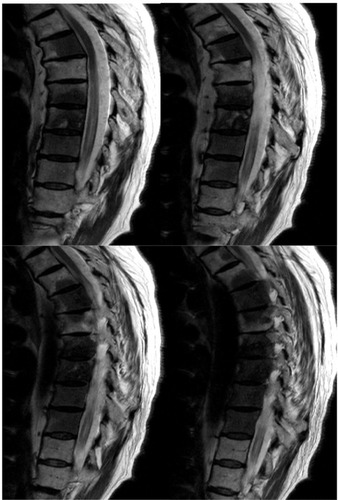Abstract
In patients with advanced stages of cancer, severe pain is commonly encountered and is very difficult to treat. It affects the quality of life of the patient and the families involved. Pain can be managed using analgesics and adjuvant therapy. However, studies have shown that at least 10%–15% of patients fail to control pain adequately and will experience severe pain. We discuss the case of a 66-year-old female with metastatic adenoid cystic carcinoma of the left submandibular gland and developed paraplegia following intercostal neurolysis with phenol. After a successful diagnostic T6 to T12 intercostal nerve block, the patient was scheduled for an intercostal neurolytic block. We injected 2 mL of 10% aqueous phenol at each level on the left from the T6 to T12 ribs. One hour after the procedure, the patient developed bilateral lower extremity weakness with difficulty moving. A physical examination showed the absence of sensation to pinpricks and vibration from T10 to S5 and an absence of anal sphincter tone and sensation. Magnetic resonance images of the thoracic and lumbar spine showed leptomeningeal metastatic disease and myelitis. We postulate that the paraplegia could be from phenol diffusing along either the spinal nerves or the paravertebral venous plexus into the subarachnoid space. This case report points to the risks involved with phenol neurolysis close to the spine, and we propose alternative methods to minimize neurological complications.
Introduction
Severe pain is a frequently encountered symptom that affects the quality of life for advanced cancer patients. It has been estimated that 60%–90% of all patients dying of cancer will experience pain in the terminal phase of their disease.Citation1–Citation3 Pain can be managed using analgesics and adjuvant therapy titrated according to the World Health Organization’s analgesic ladder.Citation4
When pain is resistant to standard therapy or when severe side effects of analgesics occur, alternative analgesic techniques should be considered. These include regional nerve blocks, intrathecal analgesic delivery methods, spinal cord stimulation, neurolytic blocks, and vertebroplasty.Citation5 Injections of neurolytic agents to destroy nerves and interrupt pain pathways have been used for many years.Citation6 In terminally ill cancer patients, phenol has been administered using the intrathecal or epidural routes for the blockade of sympathetic ganglia (celiac, superior hypogastric, ganglion impar, and so on).Citation7 Current knowledge and techniques allow these procedures to be performed safely and expeditiously, even though the risk–benefit ratio associated with neurolysis techniques is narrow. The use of phenol for neuroablation for chronic malignant pain is widely accepted, especially when the life expectancy is low. We discuss a case of paraplegia followed by phenol intercostal neurolysis for intractable intercostal neuralgia.
Materials and methods
A 66-year-old Caucasian female was diagnosed with adenoid cystic carcinoma of the left submandibular gland in 1997. She had a left radical neck dissection, radiation, and chemotherapy. In 2005, the patient was diagnosed with extensive metastases to the pleura, lungs, breast, spleen, retroperitoneum, and bones. Since 2005, she had multiple thoracenteses and radiation therapy. The patient complained of lancinating pain in the left side of the chest, was unresponsive to medical therapy, and was referred to the pain clinic for interventional management by the oncology care team. Medical causes of chest pain were ruled out before diagnostic intercostal nerve blocks were scheduled. She had no significant medical problems other than constipation from opioids, and she had a 20 pack-year smoking history.
The patient was brought to the operating room and was placed in a prone position. Standard American Society of Anesthesiologists monitoring was applied, and the patient received anesthesia with an intravenous midazolam, fentanyl, and propofol infusion. The patient’s back was prepared and draped in a sterile fashion. We had decided to proceed with an intercostal neurolytic block when the patient reported 60%–70% pain relief for about 6–8 hours with a diagnostic T6 to T12 intercostal nerve block. The left T6 to T12 ribs were identified 6–7 cm from the midline and marked. The inferior approach was used to insert a 1.5-inch, 25 gauge needle into the inferior border of each rib; the needle was advanced until the periosteum was contacted (). The needle tip was walked off the inferior margin of the rib and advanced 0.5 cm. After negative aspiration, 1 mL of iopamidol dye was injected, and adequate horizontal spread was seen along the inferior border. At each level, 2 mL of 10% aqueous phenol was injected with ease. The patient was sedated well and did not respond to any verbal commands. No intraoperative complications were noted.
Figure 1 Fluoroscopic view of horizontal spread of contrast dye, prone position.

One hour after the procedure, the patient was awake and had stable vital signs. However, she had bilateral lower extremity weakness with difficulty moving. A physical examination showed an absence of sensation to pinpricks and vibration from T10 to S5, no voluntary anal contraction, and an absence of anal sensation. Her bilateral lower extremity muscle strength was 0/5, and she showed an absence of deep tendon reflexes. Intravenous methylprednisolone was given, as per the National Acute Spinal Cord Injury Study III guidelines.
The patient was admitted, and a neurosurgeon and a neurologist were consulted. Magnetic resonance imaging of the thorax and lumbar spine showed extensive bony metastasis, leptomeningeal metastatic disease, and myelitis at T6 and below (). No surgical intervention was recommended, and she was referred for physical medicine and rehabilitation. There was neurogenic bladder dysfunction requiring intermittent catheterization; rectal emptying had to be regulated by laxatives. No clinical remission was seen even after 6 months of rehabilitation; hence, the neurological deficits were considered persistent.
Discussion
Poorly controlled pain can be devastating and can severely impair quality of life and activities of daily living.Citation3 Studies have shown that at least 10%–15% of patients fail to control pain adequately and will experience severe pain in spite of analgesic therapy.Citation5 As many as 46% of terminal patients receive inadequate pain treatment, as reported by family members.Citation8
Neurolysis of the intercostal nerve appears to be a cost-effective approach to treating intercostal neuralgia associated with cancer. The benefits of intercostal neurolysis include improved analgesia, reduced opioid consumption, and superior clinical effects, due to the absence of deleterious properties of high-dose chronic opioid therapy. Pain practitioners have been performing these blocks as a part of adjuvant therapy for the optimal treatment of cancer pain.
Phenol, also known as carbolic acid and as hydroxybenzene, was introduced in the 1950s.Citation9 It is a colorless, crystalline substance that has a characteristic odor and is soluble in water and organic solvents. It has been in use for neuroablation in chronic cancer pain for a long time. However, because of the complications that phenol causes, its use for chemical neurolysis for chronic noncancer pain is less common. When injected near motor nerves, phenol can produce flaccid paralysis and might also cause systemic complications, such as nausea and vomiting, central nervous system stimulation, cardiovascular depression, and cardiac arrhythmias.Citation10 Phenol can diffuse from the paravertebral gutter through the intervertebral foramina toward the epidural space, and then to the cerebrospinal fluid to cause persistent paraplegia.Citation11
Invasive use of phenol has been shown to cause irreversible neural tissue damage, and several complications have been reported.Citation10,Citation12 There was one case report in which a patient had persistent paraplegia following an intercostal block with a 7.5% aqueous phenol solution.Citation11
In our case, the patient could have developed paraplegia from the diffusion of the phenol along the spinal nerves or the paravertebral venous plexus into the subarachnoid space. It is unlikely to be intravascular, since the symptoms presented about an hour after the procedure. There is a possibility that rapid infusion of the drug could have forced the solution to diffuse faster into the spinal space, even though only 2 mL of phenol had been used. Paraplegia could also occur from vertebral or lymph node metastases or though direct extension from adjacent primary tumors, such as lung carcinoma, or through leptomeninges, thereby damaging the motor and sensory roots in leptomeningeal metastatic disease. The phenol intrathecal elimination half-life is 8 minutes, as revealed from the Renografin® solution in monkeys.Citation7 Slow diffusion of phenol through the leptomeninges at multiple levels leads to neurological damage. Deep sedation masked the immediate effects of neurological damage in our case. Leptomeningeal carcinomatosis that involves the spinal nerves often has a nodular appearance in which tumor foci appear as a string of beads throughout the cauda equina and extend out of the nerves into the neural foramina. Along the spinal cord, a leptomeningeal tumor typically presents as a thin coating along the pia mater, although nodularity and diffuse involvement of the arachnoid space also can occur.
These are some alternative methods to minimize the neurological complications with intercostal neurolysis in leptomeningeal metastatic disease:
Especially for the blockade of peripheral nerves near the spine, lipid phenol should be used instead of aqueous solutions, because diffusion and unwanted damage cannot be excluded reliably.Citation11 (The use of phenol solutions in water may result in 50 times higher toxicity than that of lipid phenol.)Citation13
For leptomeningeal metastatic disease, radiofrequency neuroablation is an alternative treatment method to phenol for intercostal neurolysis, which is used in the treatment of the most common chronic nonmalignant pain syndromes.Citation14
Intercostal neurolysis should be performed at the midaxillary line,Citation15,Citation16 far from the costovertebral joint.
Mild sedation with patient communication during the intercostal neurolysis procedure minimizes the chance of developing permanent neurological damage.
Conclusion
This case highlights the risk associated with aqueous phenol application in the vicinity of the spinal cord for leptomeningeal metastatic disease. We recommend that patient selection prior to the interventional pain treatment is very important. We also recommend that alternative methods be used for intercostal neurolysis in leptomeningeal metastatic disease patients whenever possible.
Disclosure
The authors report no conflicts of interest in this work.
References
- KeefeFJAbernethyAPC CampbellLPsychological approaches to understanding and treating disease-related painAnnu Rev Psychol20055660163015709948
- PortenoyRKCancer pain. Epidemiology and syndromesCancer198963Suppl 11229823072655867
- ChristoPJMazloomdoostDCancer pain and analgesiaAnn N Y Acad Sci2008113827829818837907
- Cancer pain relief and palliative careReport of a WHO Expert CommitteeWorld Health Organ Tech Rep Ser19908041751702248
- SloanPAThe evolving role of interventional pain management in oncologyJ Support Oncol20042649150050315605916
- MaherRMIntrathecal chlorocresol in the treatment of pain in cancerLancet19632817288965967
- ConcilusRRSehlhorstCSDensonDDKatzJGreggRVDural transfer of phenol following epidural injection in cynomologus monkeys [abstract]Anesthesiology1988693AA399
- TolleSWTildenVPRosenfeldAGHickmanSEFamily reports of barriers to optimal care of the dyingNurs Res200049631031711093695
- PattRBCancer PainPhiladelphia, PALippincott Williams & Wilkins1993
- Superville-SovakBRasminskyMFinlaysonMHComplications of phenol neurolysisArch Neurol19753242262281124986
- KowalewskiRSchurchBHodlerJBorgeatAPersistent paraplegia after an aqueous 7.5% phenol solution to the anterior motor root for intercostal neurolysis: a case reportArch Phys Med Rehabil200283228328511833036
- GaliziaEJLahiriSKParaplegia following coeliac plexus block with phenol. Case reportBr J Anaesth19744675395404458776
- CainHDSubarachnoid phenol block in the treatment of pain and spasticityParaplegia1965321521605898422
- Van ZundertJRajPErdineSvan KleefMApplication of radiofrequency treatment in practical pain management: state of the artPain Pract20022326927817147743
- ScottDBTechniques of Regional Anesthesia2nd edNorwalk, CTAppleton and Lange1995
- KreuscherHRegionale SchmerztherapieNieselHCRegionalana¨sthesie, Lokalana¨sthesie, Regionale SchmerztherapieStuttgart, GermanyGeorg Thieme1994709761

